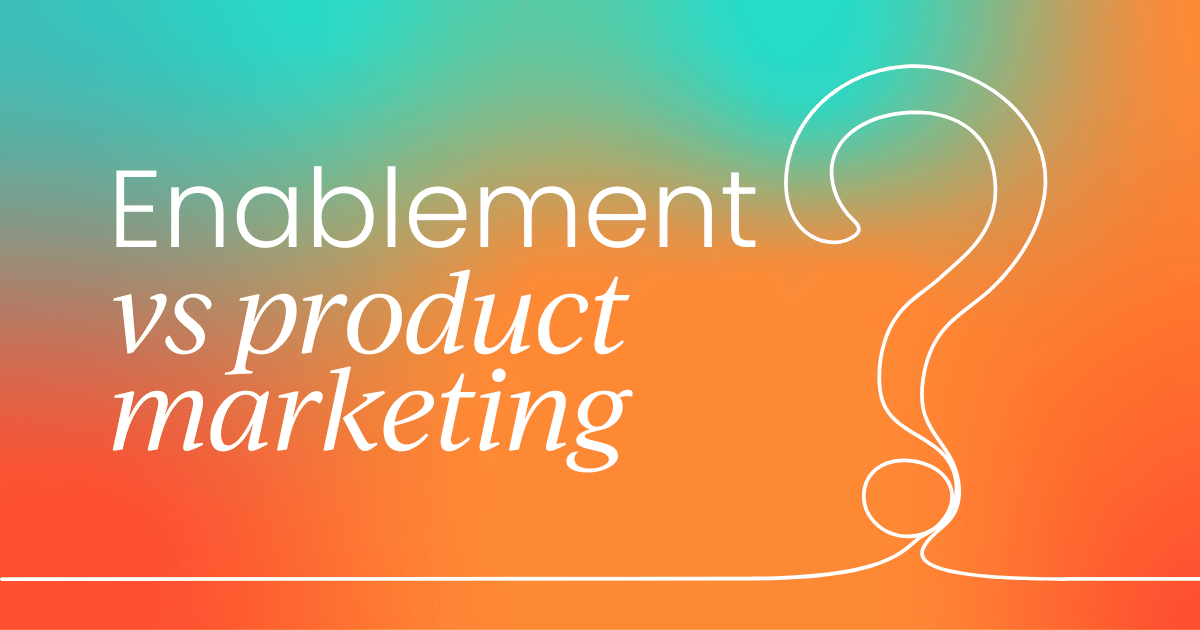Sales enablement and product marketing. Two disciplines often misunderstood, or worse, confused as the same function.
These functions may work in similar areas, but their expertise differs quite dramatically. Product marketers focus on promoting products to customers and bringing features to market, while sales enablers focus on training and supporting your sales team.
That’s not to say these functions don’t share some overlap – product marketers and enablers are both known to create sales collateral. The true power in these teams is when they collaborate to promote uniform product messaging across your organization and beyond.
But let’s not get ahead of ourselves. This article covers:
- What product marketing is
- What sales enablement is
- 7 key differences
- The overlap between the functions
- Best practices for aligning these teams
What is product marketing?
Product marketing is a subset of marketing focused on bringing a product to market, promoting it to customers, and generating demand for the product.
Essentially, product marketing bridges the gap between the product and the customer by crafting the perfect messaging and positioning to target your ideal customers. This involves countless hours of research, strategy, and collaboration.
Product marketing managers (PMMs) play a critical role in a successful product launch, from understanding the market, conducting competitor research, and crafting the perfect messaging to creating a pricing strategy, and planning launch assets.
In the increasingly busy marketplace, you run the risk of your product launch disappearing into the noise without a PMM’s help.
Some of the roles and responsibilities of a PMM include:
- Market research
- Messaging and positioning
- Pricing strategy
- Defining buyer personas
- Managing product launches
- Competitive intelligence
What is sales enablement?
Since you’re on our site there’s a good chance you already have a basic understanding of sales enablement, but just in case you’re unsure…
Sales enablement is a support function focused on enabling your sales team to close deals by creating training materials, collateral, and coaching programs.
Enablement professionals also conduct onboarding programs to help new reps get to grips with the processes at their company.
Essentially, this function aims to increase seller productivity and revenue by enabling sellers to excel in their roles and close more deals. This can be through upskilling initiatives such as training and coaching, or through knowledge-sharing activities such as creating battlecards, sales playbooks, and product cheat sheets.
Some roles and responsibilities of sales enablement include:
- Sales rep onboarding
- Training and coaching the sales team
- Creating and distributing sales collateral
- Measuring sales performance
- Sharing product knowledge with the sales team
Key differences between product marketing and sales enablement
Just in case it isn’t yet clear how these two functions differ, let’s break down the seven key areas where these two teams’ knowledge and responsibilities diverge.
Goals
The first difference between these two functions is their goals. Product marketing aims to effectively market your product to your target audience to generate leads. This means generating product awareness and demand, but not necessarily generating sales.
Whereas sales enablement teams look to boost seller productivity and increase deals won. Their impact will directly affect how sales reps approach conversations with prospects and therefore is crucial to increasing revenue.
KPIs
Different goals means different measures of success. So, these teams keep track of different metrics to prove their ROI.
Product marketing teams tend to track metrics such as:
- Customer acquisition cost. The cost of gaining a new customer.
- Customer engagement. How engaged your customers are with your product and campaign.
- Product usage. Tracks how your customers use your product and how often.
- Customer retention. Measures how well your product retains customers.
- Campaign performance. This can include social media metrics, email open rates, and conversion rates, but essentially measures how well your marketing campaign performed.
While sales enablement pros track:
- Time to productivity. How quickly after onboarding, a sales rep closes their first end-to-end deal.
- Available selling time. The amount of time sales reps spend on calls, outreach, and other attainment activities.
- Content usage. Measures which sales collateral is being used and how often.
- Sales confidence. Tracks how confident and knowledgeable your sales team feels.
- Win/loss rate. The ratio of deals closed-won versus deals closed-lost.
Activities
Sales enablement and product marketing also vary in their day-to-day activities and tasks.
PMMs focus on building out a stellar marketing strategy for your product. This involves defining product positioning and messaging, detailing buyer personas, and strategizing the details of the next product launch plan.
That’s not to mention executing these launch plans through various channels (email, social media, blog content, whitepapers, paid ads, billboards, etc) and tracking the success of these campaigns.
Sales enablement professionals, on the other hand, focus on supporting sellers to win deals. On the day-to-day level, this means hosting training workshops, creating sales collateral, tracking sales metrics, onboarding new sellers, and optimizing existing programs.
Audience
The next main differentiator is the audience and key stakeholders of these teams’ efforts.
Product marketing focuses on sharing the product value externally, by directly with prospective customers and tailoring marketing efforts to suit different ICPs. Whereas enablement pros work internally to ensure sales reps understand the value proposition of the product and can effectively sell your offering to customers.
In short, product marketing connects directly with customers, while enablement connects directly with sales and indirectly with customers.
Feedback loop
Similar to the audience differences, these teams are also part of different feedback loops.
PMMs gather feedback from the market and customer opinions to refine their marketing strategies and buyer personas. Enablers gather feedback from the sales team to improve sales collateral and training programs.
Tools
With differing responsibilities, product marketers and sales enablers also utilize different tools to help them complete their work.
Some common product marketing tools include:
- Marketing automation platforms
- Content creation tools
- Competitive analysis software
- Customer feedback trackers
While sales enablement professionals typically use:
- Customer relationship management (CRM) systems
- Sales training platforms
- Content management systems (CMS)
- Conversation intelligence tools
Relationship with sales
Product marketing teams don’t have a strong relationship with sales, but they do share crucial product knowledge, messaging, and resources with the sales team to help them sell.
On the flip side, sales enablement teams have a strong relationship with sales reps and sales leadership. Helping the entire sales team to meet their goals through training and support.
Overlap of product marketing and sales enablement
Remember back at the beginning of this article, where we hinted that there was some overlap between product marketing and sales enablement? This section covers that overlap and helps to clear up why these functions often get confused.
Messaging
Having strong product messaging is essential for creating product-market fit and effectively positioning your product in the marketplace. Messaging is the story your customers buy alongside your product, so it needs to be compelling and uniform.
Both teams work to ensure product messaging is cohesive across your organization.
First, product marketing crafts the messaging and spreads it to customers via marketing efforts. Then sales enablement is briefed on this messaging, so they can educate sales reps on the language to use when selling.
Without sales enablement, sales reps wouldn’t be aligned on the product’s messaging, leaving sales and marketing with mismatched communications with customers.
(Or in some organizations, product marketers may take on this role, in the absence of an enablement pro, which is why PMMs often report “sales enablement” as part of their role.)
Content
For simplicity, we’ve explained that enablement professionals produce and distribute sales content. While this is true, it isn’t the full story…
The truth is, product marketers are often tasked with creating some sales collateral too. This makes sense, as PMMs are often the experts on product positioning and messaging, as well as competitive intelligence within an organization.
When enablement and product marketing work together, they can create effective sales content by combining their expertise. Enablement can provide insights into which formats work best, and PMMs can provide product and market knowledge (more on this later).
Supporting sales
We already mentioned the different relationship PMMs and enablers have with the sales team and that’s still true, but at the end of the day, product marketing also step in to support sales.
Whether it's creating sales collateral, sharing product knowledge, or passing over marketing qualified leads, product marketing understands that supporting sales ultimately leads to increased sales.
Impact customers
While sales enablement professionals don’t typically interact directly with customers, they still impact customer interactions.
The training and coaching they provide to sales reps translate into a better experience for customers, as they are more knowledgeable and considerate of prospect’s needs.
And, as we’ve previously highlighted, PMMs also impact customers through their marketing efforts. Meaning both of these functions contribute to customer experience in some fashion.
Best practices for aligning sales enablement and product marketing
To truly see the power of product marketing and sales enablement in your organization, these functions need to be aligned. Here are our top tips to ensure your PMMs and enablers are on the same page.
Strategy meetings
Hosting joint strategy meetings on a regular basis can allow for increased communication and idea sharing.
This may involve sharing plans, goals, and schedules to make sure they align across these teams. Aligning around common objectives can ensure PMMs and enablement pros are working with each other's interests in mind.
Content creation
When it comes to content creation, product marketers and sales enablers should work together, and make use of each other’s expertise.
Sales enablement teams can inform the best formats for certain types of sales content, and can create effective sales methodology cheat sheets. Whereas PMMs can provide insights into product messaging and write battlecard comparing competitors.
PMMs can also provide information about an upcoming launch to give the sales enablement team enough time to create new content for the sales team.
Feedback loop
Creating a feedback loop between sales enablement and product marketing is essential for successful alignment. Passing insights back and forth will help to inform each other’s strategy and activities.
Here are some examples of insights to feedback:
- The product messaging for X product has changed.
- Our customer research shows Y is a new competitor to our brand.
- Sellers say our customers regularly suffer with Z pain point.
- Sales reps prefer A type of sales collateral over B.
Analytics
Don’t just share these qualitative insights and tidbits of information. It’s also important to crunch the numbers together to see the data behind the feedback.
- Which pieces of content are used most frequently?
- Which pieces of content most commonly lead to a won deal?
- Which channels are customers most likely to convert from?
Asking these analytical questions (and others) helps to back up feedback and monitor the performance of enablement and PMM joint activities. With this data being shared, these teams can work together to create an even stronger customer journey.
TL;DR
Here’s a quick rundown of what we covered:
- Product marketing focuses on promoting a product to customers by crafting messaging and conducting market research.
- Sales enablement focuses on supporting the sales team through training and content.
- While PMMs interact directly with customers, enablers interact indirectly with customers via sales reps.
- The functions have different goals, KPIs, and tools to help them perform their day-to-day activities.
- These functions are often mixed up as they share some overlap in these areas: messaging, content, supporting sales, and impacting customers.
- Aligning these two functions can improve the effectiveness of both team’s output through knowledge sharing.


Sales enablement insider
Thank you for subscribing
Level up your sales enablement career & network with sales enablement experts
An email has been successfully sent to confirm your subscription.
 Follow us on LinkedIn
Follow us on LinkedIn


.png)










